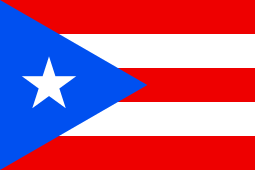In 2017, Category 5 Hurricane Maria hit the Caribbean, killing 3,059 people, mostly in Puerto Rico, but also in Dominica, Haiti and the United States. Maria was the deadliest Atlantic Hurricane in 183 years. After the devastating storm, former president Donald Trump drew criticism for holding up billions in aid to Puerto Rico and calling Puerto Ricans lazy. He also made the news for tossing paper towels at hurricane survivors when he finally traveled to the island.
Discrimination against Puerto Ricans didn’t begin with Trump, though. For centuries, the indigenous Taíno population inhabited the island. After the arrival of Christopher Columbus and the Spanish colonizers, the Taíno population declined significantly, not unlike Indigenous peoples in what is now called the United States. In 1898, war between Spain and the U.S. broke out, largely over the indigenous-led independence movement in Cuba against Spanish rule. The U.S. seized on the opportunity, leading to the Spanish-American War. The U.S. won, and acquired the Spanish colonies of Guam, the Philippines and Puerto Rico. Cuba gained an independence that was very closely monitored by the U.S. until the Cuban Revolution of 1959. Guam remains a U.S. territory, while the Philippines gained independence after World War II and Puerto Rico has been claimed as a territory since 1898.
After annexation, Puerto Rico has been treated like a colony by the mainland United States government. Puerto Ricans cannot vote in U.S. presidential elections, and although they have the right to elect delegates to the U.S. Congress, like other territories, those delegates cannot vote. After annexation, the U.S. appointed military governors who maintained strict control over the island until democratic elections were instated under President Truman. On May 21, 1948, Governor Jesus Piñero, the last appointed governor, imposed “la ley de mordaza”, or a gag law, on Puerto Rico. Gag laws prohibit discussion about topics the government wants to silence. This law in particular banned Puerto Rican nationalism and patriotism and forbade the displaying of the Puerto Rican flag and was not repealed, being declared unconstitutional, until a decade later.
U.S. doctors have been notorious for conducting medical experiments in Puerto Rico. Puerto Rican women were told by U.S. officials that they were receiving safe, reversible birth control procedures, but were instead subjected to dangerous experimental treatments or sterilization surgeries to which they didn’t consent. Many of these operations were approved by the Puerto Rican Eugenics Board. Dr. Cornelius Rhoads, a U.S. doctor, purposefully infected Puerto Ricans with cancer. The U.S. was also responsible for many massacres of Puerto Rican people during and after the Spanish-American War, such as the Ponce and Rio Piedras Massacres, which killed 19 and 4 people respectively.
The U.S. Navy has also used the Puerto Rican island of Vieques as a military base. For decades, the eastern half of the island was used as a testing ground for weapons, including nuclear weapons. According to the Puerto Rican Health Department, Viequenses are 27% more likely to be diagnosed with cancer than those living on the main island due to the radiation from these tests. The Navy was repeatedly cited by the EPA for violating the Clean Water Act during the weapons tests, but a federal district court in Puerto Rico ruled that the Navy was acting under its legal obligations, and anyone harmed was “collateral damage.”
Puerto Rico has been subject to neoliberal values from the Reagan Era to the present. In the 1980s, Puerto Rico privatized its public health and telephone systems, offered tax incentives to mainland U.S. businesses who operated on the island and rewrote labor laws to be favorable to employers rather than workers.
In 2012, the Luis Muñoz Marín International Airport in San Juan was privatized, starting a new wave of neoliberalism that functioned as a reaction to the debt imposed on Puerto Rico largely due to tax breaks for companies starving the government of funds. In 2016, the Puerto Rico Oversight, Management, and Economic Stability Act (PROMESA) established the Fiscal Control Board (FCB) to handle economic matters. PROMESA handed over control of Puerto Rico’s budget from the state legislature to the FCB, which answers to the federal government, once again putting Puerto Rico’s budget under U.S. federal control.
After Hurricane Maria, Puerto Rico’s former Governor Ricardo Roselló and former president Donald Trump set out to privatize as much as possible, including the energy grid and the school system. In fact, part of the billions in aid that Trump held back from the island were withheld in order to force Puerto Rico to privatize the electric grid. Part of the 2017 Tax Cuts and Jobs Act, which Democrats and Progressives criticized as a “tax cut for the rich,” established Opportunity Zones, which are tax havens overseen by the Department of Housing and Urban Development. Opportunity Zones were capped at 25% of a state’s area, but an exception was made for Puerto Rico, which saw 98% of the land turned into an Opportunity Zone, further starving the state of funds. The Center for American Progress denounced this as “government-sanctioned gentrification.”
Although Puerto Rico and the U.S. have new executives, Governor Pedro Pierluisi and President Joe Biden, the situation remains largely the same. PROMESA remains in effect, and Governor Pierluisi is a former member of the FCB. Even as Representatives Alexandria Ocasio-Cortez (D-NY) and Nydia Velázquez (D-NY), both Puerto Rican-Americans, propose legislation to relieve Puerto Rico’s debt and allow Puerto Rico more sovereignty, the future of Puerto Rico’s status remains unclear.

